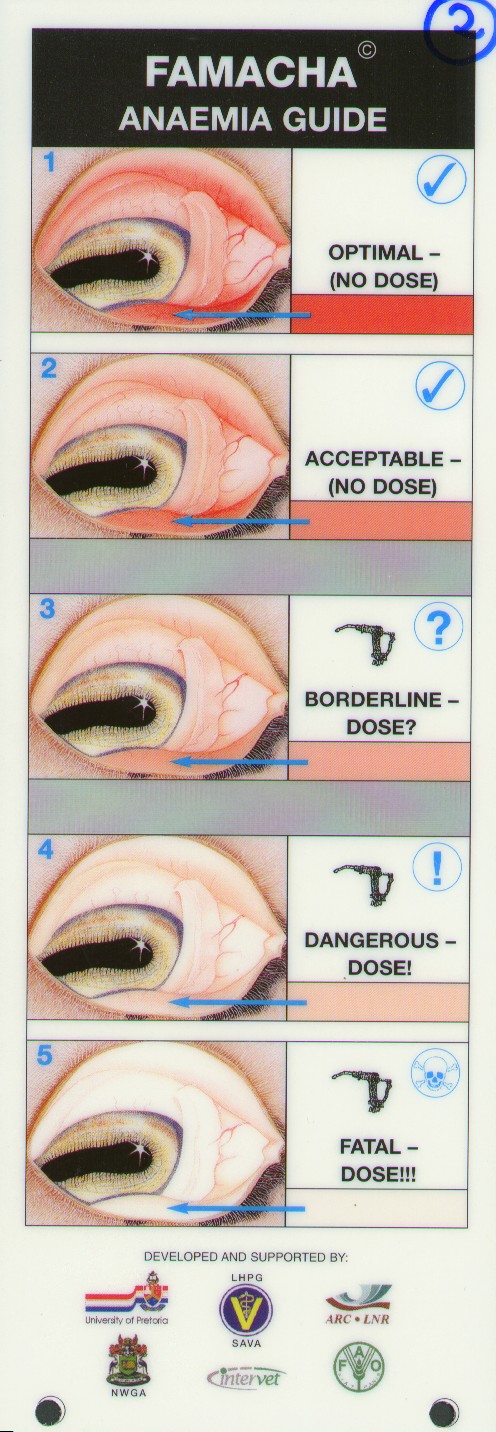Project
FAMACHA© color chart in the sheep and goat farming
Identification of sheep and goats with the FAMACHA© color card for selective deworming
A stomach parasite can cause life-threatening anemia in sheep and goats. The pallor of conjunctivae, compared with a color chart developed in South Africa indicates those animals that need to get dewormed. Is this method also useful and applicable in German farms?
Background and Objective
The effects of latent, not apparent worm infestations are often underestimated by farmers and their advisors. Parasites from pasture cause great losses in Germany. More than half of organic sheep farmers stated that endoparasites are among the most common animal health problems in their herds. Worm infestation is by far the most common disease problem in organic sheep. Particularly pathogenic is the blood-sucking, abomasal worm Haemonchus contortus. Especially lambs but also adult animals can develop such a strong anemia in mid-July that they die of it. Only a deworming will help.
For the last decades, the same active ingredients are used in worm control. As a result anthelmintic-resistant strains of gastrointestinal worms have become increasingly common in small ruminants. The agents act not as good, the frequency of treatments must be increased. In some non-European countries, farmers are already threatened with extinction, because the worms have developed resistance to all available anthelmintics. Spread of such worms can be delayed via a partial treatment of flock instead of the usual total herd treatment. This reduces the selection pressure and anthelmintic sensitive worms have the same chances of survival as the resistant have. The targeted treatment is also associated with reduction in medicaments; up to 90% should be possible. Since usually only a minority of the flock is heavily infested, you could treat only these animals.
The problem consists in the reliable identification of these animals. One method is the fecal examination and determination of the individual egg excretion. Unfortunately, this method is uncertain, additionally to the considerable workload, because we cannot deduce from excretion of eggs on the number of worms inside the host animal (worm burden). In South Africa, where H.contortus is the main threat to small ruminants, has been developed and tested the FAMACHA©-Eyecolor-Chart system. A check done routinely on the conjunctivae with a color chart in 5 shades can filter out the very pale animals for treatment. After short briefing, farmers can perform this test on their own. The method has the aim of identifying only animals really in need of treatment.
Several field studies demonstrate the success of the method when H.contortus is the main challenge. Until now in Germany was found only low correlations between FAMACHA© value and hematocrit or egg excretion.
To verify the feasibility of the FAMACHA©-test we conducted three field studies with sheep and goats at the Institute for Organic Farming during the grazing seasons 2002, 2003 and 2005.
Approach
In 2002, forty naturally infected, firstseason- and secondseason-grazing sheep and goats were examined every 14 days throughout the grazing season using FAMACHA© system. At the same time, the numbers of eggs per gram of fresh feces were determined and every 8 weeks, the hematocrit (percentage of red cell mass in the total blood) as a measure of anemia was determined. The worm burden in the gastrointestinal tract was determined by the section of four lambs and kids (tracer animals). The paleness of conjunctivae was detected by examination of the mucosa of the lower lid. By direct comparison with the FAMACHA© card, the values were determined: 1 = red (not anemic); 2 = pink-red (that is not anemic); 3 = pink (moderate / suspicious); 4 = pale-pink (that is anemic); 5 = very pale (that is heavy anemic). Since the color gradations proved to be too coarse, intermediate values are admitted. All investigators were given a brief introduction to the method. They were required to examine the conjunctivae quickly and by consulting the color chart for comparison they have to declare the value. A volunteer has listed the values.
The FAMACHA© values were collected during the weighing by farmers, veterinarians and a student of Agricultural Sciences. Conditions on farm were simulated.
During the summer of 2003 several times FAMACHA© values and individual animal fecal samples were examined at 46 lactating goats in the milking parlor.
In the grazing period 2005, animals the most in need of treatment should be found before a scheduled deworming by a flashlight-like investigation. For this purpose, the hematocrit, the FAMACHA© values and the number of worm eggs in feces of 55 adult goats was uniquely determined.
Data and Methods
The number of eggs per gram of fresh feces (EPG) were counted in individual fecal samples with the McMaster method, in with a counted egg corresponded to 33 EPG. The hematocrit was determined from heparinized venous blood by the micro method. From pooled fecal samples larvae were grown and differentiated in order to calculate the relative degree of infestation. After section and wash out the gastrointestinal tract the worm burden of tracer animals was determined by aliquots (10%).
Results
In August 2002, the average worm burden of the bloodsucking H. contortus in larval cultures was 24.6% in sheep and 12.4% in goats. The tracers had in early September an average worm burden of H.contortus of 22.3% (sheep) and 4.1% (goats).
The FAMACHA© test could be performed quickly and easily for man and animal. However, frequent correcting during the testing led to the conclusion that the reversed scale is unusual to the current expectation (the value "1" is dark red). Also finer gradations of color in the middle range are necessary for the goats.
The proportion of falsely pale identified goats was very high at 65%, with the sheep it was 42%. This trend is consistent with the experience of other investigations. However, all animals that were actually too pale were found. This sensitivity is crucial for a screening test. However, the relationship between the FAMACHA© value and the measured hematocrit was only low to moderate. Reliable correlations could not be calculated between FAMACHA© value and worm egg output.
The unique, flash-type examination revealed no reliable results.
The disappointing outcome, in comparison with non-European field studies, is likely to be explained by the relatively small proportion of H.contortus at the total worm burden and the overall good general condition of the animals. In the experiment from 2002 only 9 out of 149 samples at the goats, and 10 out of 154 samples in sheep remained below the limit for anemia (0.28 l/l hematocrit). A close relationship between FAMACHA© value and hematocrit could not be proven with our goats and sheep. The infection with blood-sucking gastrointestinal worm H.contortus however, was not so high that clinical anemia has arrived. Similarly, a conclusion from FAMACHA value to the egg excretion was not possible.
The FAMACHA© test could still be suitable for the identification of particularly pale animals. In herds that have major problems with the red stomach worm, this would lead to a timely diagnosis. The investigations should be performed steadily at intervals of e.g. two weeks. The considerable amount of work will certainly be affordable only in single cases. And be aware: This test is exclusively created for H.contortus; the infestation with other gastrointestinal worms can therefore not be detected.
Links and Downloads
Duration
1.2002 - 1.2005
More Information
Project status:
finished
Publications
- 0
Koopmann R (2007) Ist die FAMACHA-Eye-Colour-Karte zur klinischen Diagnose von Haemonchus contortus-Befall bei Schafen und Ziegen in Norddeutschland geeignet? In: Zikeli S, Claupein W, Dabbert S (eds) Beiträge zur 9. Wissenschaftstagung Ökologischer Landbau "Zwischen Tradition und Globalisierung" : Universität Hohenheim, 20.-23. März 2007 ; Bd. 2. Berlin: Köster, pp 669-672
- 1
Koopmann R, Holst C, Epe C (2006) Erfahrungen mit der FAMACHA-Eye-Colour-Karte zur Identifizierung von Schafen und Ziegen für die gezielte anthelminthische Behandlung. Berl Münch Tierärztl Wschr 119(9-10):426-442

![[Translate to English:] [Translate to English:]](/media/_processed_/8/e/csm_Bildschirmfoto_2021-03-03_bearb_fc48ac88bf.jpeg)
![[Translate to English:] [Translate to English:]](/media/_processed_/8/e/csm_Bildschirmfoto_2021-03-03_bearb_ba3ec0e9d7.jpeg)


![[Translate to English:] Logo des Bundesministerium für Ernährung und Landwirtschaft](/media/allgemein/logos/BMEL_Logo.svg)